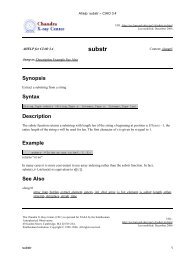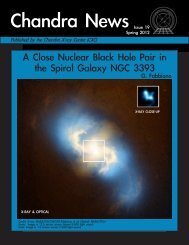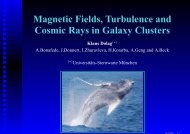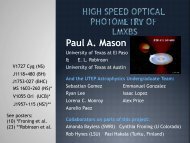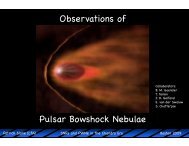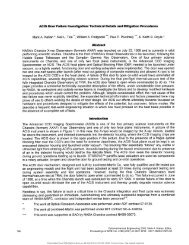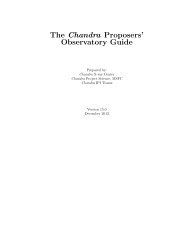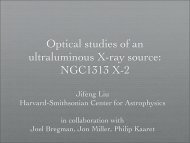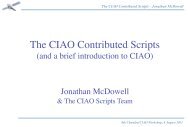Paper Title - Chandra X-Ray Observatory (CXC)
Paper Title - Chandra X-Ray Observatory (CXC)
Paper Title - Chandra X-Ray Observatory (CXC)
Create successful ePaper yourself
Turn your PDF publications into a flip-book with our unique Google optimized e-Paper software.
observations together is not guaranteed to force the optimization routine to schedule observations as<br />
requested. The mission schedulers, therefore, do a fair amount of troubleshooting, trying to get the<br />
optimization routine to return a schedule that matches the observing plan laid out in the ORViewer.<br />
Once the OFLS schedule is successfully replicating the observing plan laid out in the ORViewer, the<br />
schedule products are passed to an external algorithm for star selection. The OFLS scheduling software<br />
identifies candidate guide stars for observations before scheduling them, and only schedules observations<br />
its algorithm determines have adequate stars. With the original settings, this algorithm disallowed many<br />
observations. Clearly, approved observations need to be observed and should only be disallowed as a last<br />
resort, so the star selection parameters were relaxed to allow observations to schedule. The relaxation had<br />
the unfortunate side effect of producing catalogs with insufficient stars for accurate aspect reconstruction<br />
and, sometimes, for adequate attitude reference. Initially, unacceptable catalogs were edited by hand, with<br />
ACA engineers hand selecting desirable stars and mission planners editing them into command products.<br />
Over time the process was automated into tools and scripts. Finally, a working group of PCAD and ACA<br />
Engineers and Mission Planners defined a star selection algorithm that shifted the way star selection was<br />
performed. It assumed that an adequate catalog would be found for all observations, and accepted the risk<br />
of a re-schedule if one could not be. The algorithm was coded into a stand alone tool, the Simple AXAF<br />
User Select Acquisition and Guide star Editor (SAUSAGE), that would be used to replace every star<br />
catalog used in mission schedules. SAUSAGE also provided a GUI interface for viewing and editing star<br />
catalogs. The tool is used to this day and observations are very rarely rescheduled due to poor quality star<br />
catalogs.<br />
Once<br />
stars have been replaced the schedule products are used to generate command products, which can be<br />
uplinked to the spacecraft. The scheduling software and the command load generation software have a<br />
single interface, the Detailed Operations Timeline (DOT). The DOT is simply a formatted text file, so it<br />
can be easily modified. The DOT is what allows replacement of star catalogs after the fact and provides a<br />
means for mission schedulers to correct small scheduling problems by hand. While hand editing schedules<br />
is not desirable, it provides ultimate flexibility. This flexibility has proven to be a necessity in efficiently<br />
generating mission schedules. The command load generation software processes the DOT and uses<br />
predefined command sequences to generate command loads.<br />
Once<br />
the schedule has been made into command loads, the schedule and command products are packaged<br />
for review. The review package is ingested by a suite of independently developed and maintained set of<br />
Perl scripts, Backstop, that reverse engineer the command loads into command mnemonics and time-tags.<br />
The resulting report is processed and reviewed by each subsystem, both science instrument teams and<br />
science mission planning. Each reviewer reports back to the FOT Mission Planning Manager identifying<br />
any problems detected in the loads or approving the load set. Once review comments have been received<br />
from every review team, problems are addressed by rescheduling or by editing the DOT and new command<br />
loads are generated. The new command loads go through the same review process until no problems are<br />
reported. Once every reviewer has approved the load set they are approved by the FOT Mission Planning<br />
Manager and Flight Director. Approved command loads are saved into a database, which enables the<br />
spacecraft controllers to uplink them to the spacecraft.<br />
The<br />
scheduling process, from receipt of the OR list to command load uplink, takes approximately two and a<br />
half weeks to complete. The end-to-end process is summarized in Fig. 3. While the process may seem<br />
manual and labor intensive, it is highly effective and generally well controlled. An average of 93% of<br />
available science time is used for observations. New constraints or requests are incorporated quickly.<br />
Finally, when questions or problems arise the Mission Planner responsible for the week knows the details<br />
of every decision made in scheduling that week and can, therefore, respond more quickly and accurately.



